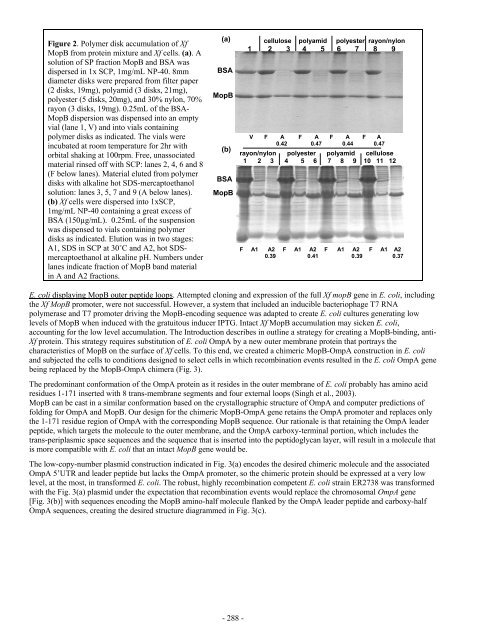Impact Of Host Plant Xylem Fluid On Xylella Fastidiosa Multiplication ...
Impact Of Host Plant Xylem Fluid On Xylella Fastidiosa Multiplication ...
Impact Of Host Plant Xylem Fluid On Xylella Fastidiosa Multiplication ...
You also want an ePaper? Increase the reach of your titles
YUMPU automatically turns print PDFs into web optimized ePapers that Google loves.
Figure 2. Polymer disk accumulation of Xf<br />
MopB from protein mixture and Xf cells. (a). A<br />
solution of SP fraction MopB and BSA was<br />
dispersed in 1x SCP, 1mg/mL NP-40. 8mm<br />
diameter disks were prepared from filter paper<br />
(2 disks, 19mg), polyamid (3 disks, 21mg),<br />
polyester (5 disks, 20mg), and 30% nylon, 70%<br />
rayon (3 disks, 19mg). 0.25mL of the BSA-<br />
MopB dispersion was dispensed into an empty<br />
vial (lane 1, V) and into vials containing<br />
polymer disks as indicated. The vials were<br />
incubated at room temperature for 2hr with<br />
orbital shaking at 100rpm. Free, unassociated<br />
material rinsed off with SCP: lanes 2, 4, 6 and 8<br />
(F below lanes). Material eluted from polymer<br />
disks with alkaline hot SDS-mercaptoethanol<br />
solution: lanes 3, 5, 7 and 9 (A below lanes).<br />
(b) Xf cells were dispersed into 1xSCP,<br />
1mg/mL NP-40 containing a great excess of<br />
BSA (150µg/mL). 0.25mL of the suspension<br />
was dispensed to vials containing polymer<br />
disks as indicated. Elution was in two stages:<br />
A1, SDS in SCP at 30˚C and A2, hot SDSmercaptoethanol<br />
at alkaline pH. Numbers under<br />
lanes indicate fraction of MopB band material<br />
in A and A2 fractions.<br />
(a)<br />
BSA<br />
MopB<br />
(b)<br />
BSA<br />
MopB<br />
cellulose polyamid polyester rayon/nylon<br />
1 2 3 4 5 6 7 8 9<br />
V F A F A F A F A<br />
0.42 0.47 0.44 0.47<br />
rayon/nylon polyester polyamid cellulose<br />
1 2 3 4 5 6 7 8 9 10 11 12<br />
F A1 A2 F A1 A2 F A1 A2 F A1 A2<br />
0.39 0.41 0.39 0.37<br />
E. coli displaying MopB outer peptide loops. Attempted cloning and expression of the full Xf mopB gene in E. coli, including<br />
the Xf MopB promoter, were not successful. However, a system that included an inducible bacteriophage T7 RNA<br />
polymerase and T7 promoter driving the MopB-encoding sequence was adapted to create E. coli cultures generating low<br />
levels of MopB when induced with the gratuitous inducer IPTG. Intact Xf MopB accumulation may sicken E. coli,<br />
accounting for the low level accumulation. The Introduction describes in outline a strategy for creating a MopB-binding, anti-<br />
Xf protein. This strategy requires substitution of E. coli OmpA by a new outer membrane protein that portrays the<br />
characteristics of MopB on the surface of Xf cells. To this end, we created a chimeric MopB-OmpA construction in E. coli<br />
and subjected the cells to conditions designed to select cells in which recombination events resulted in the E. coli OmpA gene<br />
being replaced by the MopB-OmpA chimera (Fig. 3).<br />
The predominant conformation of the OmpA protein as it resides in the outer membrane of E. coli probably has amino acid<br />
residues 1-171 inserted with 8 trans-membrane segments and four external loops (Singh et al., 2003).<br />
MopB can be cast in a similar conformation based on the crystallographic structure of OmpA and computer predictions of<br />
folding for OmpA and MopB. Our design for the chimeric MopB-OmpA gene retains the OmpA promoter and replaces only<br />
the 1-171 residue region of OmpA with the corresponding MopB sequence. Our rationale is that retaining the OmpA leader<br />
peptide, which targets the molecule to the outer membrane, and the OmpA carboxy-terminal portion, which includes the<br />
trans-periplasmic space sequences and the sequence that is inserted into the peptidoglycan layer, will result in a molecule that<br />
is more compatible with E. coli that an intact MopB gene would be.<br />
The low-copy-number plasmid construction indicated in Fig. 3(a) encodes the desired chimeric molecule and the associated<br />
OmpA 5’UTR and leader peptide but lacks the OmpA promoter, so the chimeric protein should be expressed at a very low<br />
level, at the most, in transformed E. coli. The robust, highly recombination competent E. coli strain ER2738 was transformed<br />
with the Fig. 3(a) plasmid under the expectation that recombination events would replace the chromosomal OmpA gene<br />
[Fig. 3(b)] with sequences encoding the MopB amino-half molecule flanked by the OmpA leader peptide and carboxy-half<br />
OmpA sequences, creating the desired structure diagrammed in Fig. 3(c).<br />
- 288 -











